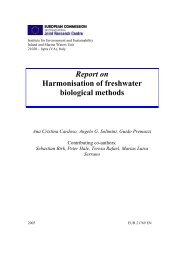Lakes and Watercourses
Lakes and Watercourses
Lakes and Watercourses
Create successful ePaper yourself
Turn your PDF publications into a flip-book with our unique Google optimized e-Paper software.
Light conditions<br />
Introduction<br />
Light conditions are crucial for the survival of many organisms. Water<br />
quality in this respect is assessed on the basis of absorbency readings<br />
taken from filtered water at a wavelength of 420 nm in a photometer or<br />
equivalent readings taken using a colour comparator, using brownishyellow<br />
platinum chloride as a reference. A high water table, eg, in bogs<br />
<strong>and</strong> marshes, results in run-off with a high humus content <strong>and</strong> hence a<br />
higher colour figure. Various chemical, photochemical <strong>and</strong> biological<br />
processes cause a certain amount of discoloration. This means that lakes<br />
with a long retention time are less discoloured than those with rapid<br />
turnover. From some points of view, a high concentration of humic<br />
matter is advantageous, since it provides scope for complexing, which<br />
reduces the toxicity of metals.<br />
The turbidity of the water is assessed by analysing light dispersion<br />
measured according to the FNU scale. These readings quantify the<br />
particulate content of the water in the form of clayey matter as well as<br />
organic matter such as humus floccules, plankton etc.<br />
Turbidity is determined electronically using a turbidimeter in<br />
accordance with the Swedish st<strong>and</strong>ard. Particles in the water scatter light<br />
<strong>and</strong>, after calibration, the intensity of this light is used as a measure of<br />
turbidity. One complication is that readings are affected by the concentration<br />
as well as the nature of the particles. The turbidity of natural<br />
running water is mainly caused by inorganic particles. The main source<br />
of material like this, which causes turbidity, is probably erosion.<br />
Inorganic matter has a high density <strong>and</strong> therefore sediments fairly<br />
quickly. <strong>Lakes</strong> thus serve as clarification basins, where the predominant<br />
cause of turbidity is usually organic matter.<br />
Measuring the Secchi depth of lakes gives an indication of the optical<br />
characteristics of the water. Secchi depth readings are taken using a<br />
Secchi dish in situ, which indicates the overall effects of water colour <strong>and</strong><br />
turbidity on light penetration. The Secchi depth thus gives a direct,<br />
simple measure of the optical characteristics of the water. It is generally<br />
considered that the Secchi depth represents the depth reached by<br />
approximately 10 per cent of natural light. A Secchi depth figure can be<br />
32















![Accommodation booking form [PDF]](https://img.yumpu.com/39471785/1/184x260/accommodation-booking-form-pdf.jpg?quality=85)

